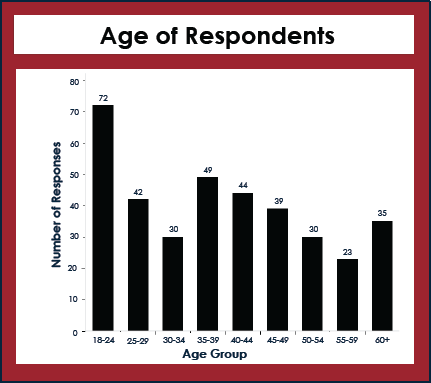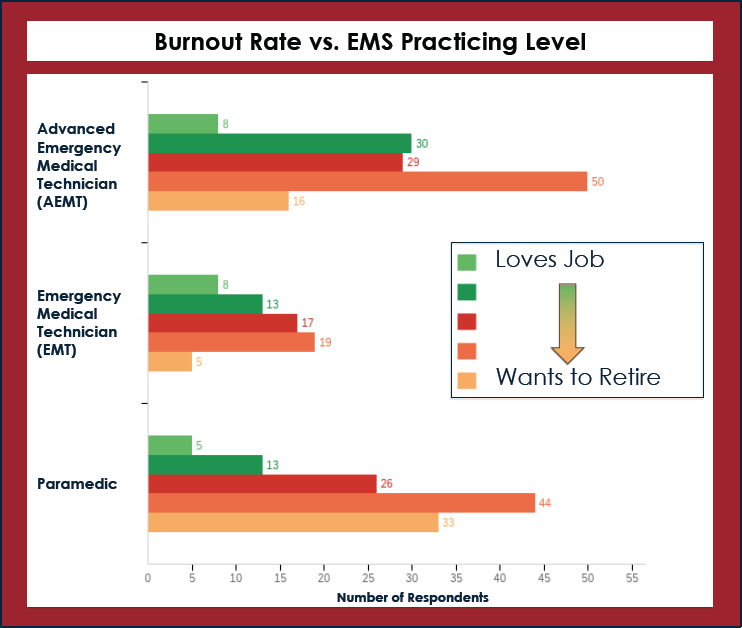College of Health
41 Burnout Among EMS Providers in Utah
London Gay; Caden Williams; and Cambrie Jessee
Faculty Mentor: Julia Franklin (Health and Kinesiology, University of Utah)
Introduction
Given the high-stress nature of emergency medical service (EMS) professions and their exposure to stressful situations, providers are at significant risk of burnout (McGary). Research has shown that elevated burnout levels can compromise both the quality and safety of patient care (Salyers) and may contribute to a future shortage of EMS personnel. Consequently, there is a growing need to assess current burnout levels among EMS providers in Utah. This research aims to identify the prevalence and key contributors to burnout within this population. The findings can serve as a foundation for developing strategies to mitigate and prevent burnout, offering valuable insights for EMS agencies and the broader community. This study was designed to determine the frequency and contributing factors to burnout among EMS providers in the state of Utah. Understanding burnout is a critical first step in safeguarding the well-being and longevity of EMS careers.
Methods
In partnership with the Utah Department of Health and Human Services, an anonymous electronic survey was distributed to licensed EMS providers in the state of Utah via email through the spring and summer of 2024. Data from the survey was collected using Qualtrics analysis software. The survey included three questions to collect participants’ demographics, and ten questions regarding their careers in EMS that are explained in more detail in the table below. These questions included: number of years working in EMS, level of certification, what geographical setting the respondent works in, and three questions to assess burnout. The questions were given in multiple formats, such as selecting all that apply, short answer, single answer, etc.
The Survey
|
Question |
Response Options |
|
Age |
18-24, 25-29, 30-34, 35-39, 40-44, 45-49, 50-54, 55-59, 60+ |
|
Race and Ethnicity |
Native American/Native Alaskan, Asian/Pacific Islander, Black or African American, African American, Hispanic/Latino, White/Caucasian, Mixed Race (Please Specify below), Other (Please Specify below), Prefer Not to Answer |
|
Self-Identified Gender |
Male, Female, Non-Binary, Transgender Male, Transgender Female, Other, Prefer Not to Answer |
|
Years in EMS Service |
Freeform response box |
|
Years at Current Job Position |
Freeform response box |
|
EMS Practicing Level |
Emergency Medical Responder (EMR), Emergency Medical Technician (EMT), Advanced Emergency Medical Technician (AEMT), Paramedic |
|
Work Setting |
Hospital, EMS/Fire Agency, Clinic |
|
Geographical Setting |
Urban, Suburban, Rural |
|
Shift Length |
Freeform response box |
|
Shifts per Week |
Freeform response box |
|
Personal Burnout Rate |
Scale of 1-5 (one being the respondent “Loves their job”, and five being they “Want to Retire”) |
|
Reasons for Burnout |
Lack of Sleep, Lack of Good Nutrition, Over- Scheduling, Financial Issues, Work Environment, Stress, Patient Ratios, Other |
|
Additional Information About Burnout |
Open response box |
Results
A total of 370 EMS personnel in Utah completed the survey, of which 340 indicated their professional classification (68 being EMTs, 142 being AEMTs, and 130 being Paramedics). The average age group was between 40 and 44 (Figure 1) with 88% of respondents selecting White/Caucasian, 2.7% selecting Hispanic/Latino, 1% selecting Black, 1.9% selecting Asian/Pacific Islander, and 6.4% selecting Other. Of the respondents, 61.3% identified as male and 34% as female, 4.7% preferred not to respond or selected “Other.”
For all respondents, the mean burnout rate was 3.39 on a five-point scale (Figure 2). Paramedics averaged 3.72 out of 5 for burnout, while AEMTs averaged 3.27 out of 5, and EMTs averaged 3.00 out of 5. The median and mode of provider burnout were both 4 out of 5. The two most reported reasons for burnout were “Lack of Sleep” and “Stress” (Figure 3).

Figure 1

Figure 2

Figure 3
Conclusion
Our findings indicate a high prevalence of burnout among EMS providers in Utah. This burnout is primarily attributed to sleep deprivation and occupational stress, though additional contributing factors include financial challenges, high patient ratios, and inadequate nutrition. Given the complexity of burnout and the potential for other influencing factors, further research is necessary to gain a comprehensive understanding of its causes. Future studies could help identify key stressors and inform targeted interventions to mitigate burnout or reduce its likelihood. Addressing burnout in EMS not only enhances the well-being and job satisfaction of providers but also improves the overall quality of patient care.
Acknowledgements
We would like to thank our faculty sponsor, Dr. Julia Franklin, Ph.D., CHES®; as well as Dr. Julie Lucero, Ph.D., MPH, Chris Stratford, MS, BSN, RN, NRP; Shelly Beck, MS, AEMT, and Mark Herrera, NRP, FP-C, for all their efforts and support throughout this study.
Bibliography
McGarry, E., & O’Connor, L. (2023). Assessing burnout rates and contributing factors in emergency medical services clinicians. Journal of Workplace Behavioral Health, 39(3), 288–301. https://doi.org/10.1080/15555240.2023.2292119
Salyers, M.P., Bonfils, K.A., Luther, L. et al. The Relationship Between Professional Burnout and Quality and Safety in Healthcare: A Meta-Analysis. J GEN INTERN MED 32, 475–482 (2017). https://doi.org/10.1007/s11606-016-3886-9

